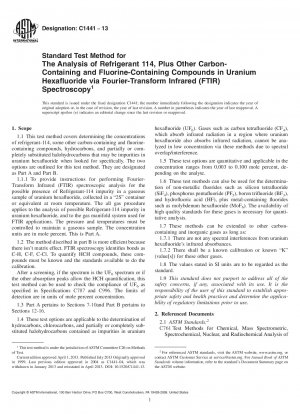ASTM C1441-13
Standard Test Method for the Analysis of Refrigerant 114, Plus Other Carbon-Containing and Fluorine-Containing Compounds in Uranium Hexafluoride via Fourier-Transform Infrared (FTIR) Spectroscopy
- Standard No.
- ASTM C1441-13
- Release Date
- 2013
- Published By
- American Society for Testing and Materials (ASTM)
- Latest
- ASTM C1441-13
- Scope
5.1 This test method (Part A) utilizes FTIR spectroscopy to determine the percent Refrigerant-114 impurity in uranium hexafluoride. Refrigerant-114 is an example of an impurity gas in uranium hexafluoride.
1.1 This test method covers determining the concentrations of refrigerant-114, some other carbon-containing and fluorine-containing compounds, hydrocarbons, and partially or completely substituted halohydrocarbons that may be impurities in uranium hexafluoride when looked for specifically. The two options are outlined for this test method. They are designated as Part A and Part B.
1.1.1 To provide instructions for performing Fourier-Transform Infrared (FTIR) spectroscopic analysis for the possible presence of Refrigerant-114 impurity in a gaseous sample of uranium hexafluoride, collected in a “2S” container or equivalent at room temperature. The all gas procedure applies to the analysis of possible Refrigerant-114 impurity in uranium hexafluoride, and to the gas manifold system used for FTIR applications. The pressure and temperatures must be controlled to maintain a gaseous sample. The concentration units are in mole percent. This is Part A.
1.2 The method discribed in part B is more efficient because there isn’t matrix effect. FTIR spectroscopy identifies bonds as C-H, C-F, C-Cl. To quantify HCH compounds, these compounds must be known and the standards available to do the calibration.
After a screening, if the spectrum is the UF6 spectrum or if the other absorption peaks allow the HCH quantification, this test method can be used to check the compliance of UF6 as specified in Specifications C787 and C996. The limits of detection are in units of mole percent concentration.
1.4 These test options are applicable to the determination of hydrocarbons, chlorocarbons, and partially or completely substituted halohydrocarbons contained as impurities in uranium hexafluoride (UF6). Gases such as carbon tetrafluoride (CF4), which absorb infrared radiation in a region where uranium hexafluoride also absorbs infrared radiation, cannot be analyzed in low concentration via these methods due to spectral overlap/interference.
ASTM C1441-13 Referenced Document
- ASTM C1052 Standard Practice for Bulk Sampling of Liquid Uranium Hexafluoride
- ASTM C761 Standard Test Methods for Chemical, Mass Spectrometric, Spectrochemical, Nuclear, and Radiochemical Analysis of Uranium Hexafluoride
- ASTM C787 Standard Specification for Uranium Hexafluoride for Enrichment
- ASTM C859 Standard Terminology Relating to Nuclear Materials
- ASTM C996 Standard Specification for Uranium Hexafluoride Enriched to Less Than 5% 235U1
ASTM C1441-13 history
- 2013 ASTM C1441-13 Standard Test Method for the Analysis of Refrigerant 114, Plus Other Carbon-Containing and Fluorine-Containing Compounds in Uranium Hexafluoride via Fourier-Transform Infrared (FTIR) Spectroscopy
- 2004 ASTM C1441-04 Standard Test Method for the Analysis of Refrigerant 114, Plus Other Carbon-Containing and Fluorine-Containing Compounds in Uranium Hexafluoride via Fourier-Transform Infrared (FTIR) Spectroscopy
- 1999 ASTM C1441-99 Standard Test Method for the Analysis of Refrigerant 114, Plus Other Carbon-Containing and Fluorine-Containing Compounds in Uranium Hexafluoride via Fourier-Transform Infrared (FTIR) Spectroscopy

Copyright ©2024 All Rights Reserved